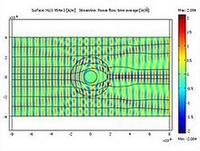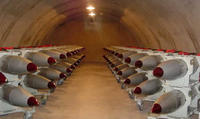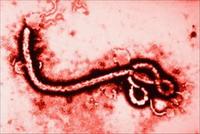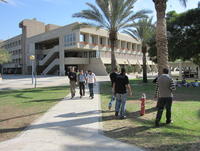-
Invisibility cloak closer to reality: Concealing military airplanes, and even people

Since the beginning of recorded time, humans have used materials found in nature to improve their lot. Since the turn of this century, scientists have studied metamaterials, artificial materials engineered to bend electromagnetic, acoustic, and other types of waves in ways not possible in nature. Now, Hao Xin, a professor of electrical and computer engineering at the University of Arizona, has made a discovery with these synthetic materials that may take engineers one step closer to building microscopes with superlenses that see molecular-level details, or shields that conceal military airplanes and even people.
-
-
U Wisconsin, shedding 1960s anti-classified research image, launches cybersecurity center
A new cybersecurity research center being built in partnership with private firms and the University of Wisconsin(UW) system aims to attract high-tech research dollars to the state, but administrators must balance the secrecy required for classified research with the openness which is the foundation of academic science. The state legislature passed a 2014 law allowing UW to accept contract for classified work partly in hopes that the school system will lose the perception of being an anti-classified-research environment, a perception dating back to campus protests against military research in the 1960s.
-
-
Research advocates urge 114th Congress to act on Top 5 science priorities in first 100 days
Research!America urged the 114th Congress to take action on five science priorities in the first 100 days of the legislative session in order to elevate research and innovation on the U.S. agenda. The organizations says that the five priorities: end sequestration, increase funding for U.S. research agencies, advance the 21st Century Cures initiative, repeal the medical device tax, and enact a permanent and enhanced R&D tax credit.
-
-
Young researchers increasingly denied research grants, putting the future of U.S. science at risk
America’s youngest scientists, increasingly losing research dollars, are leaving the academic biomedical workforce, a brain drain that poses grave risks for the future of science, according to an article published this week by Johns Hopkins University president Ronald J. Daniels. For example, the number of principal investigators with a leading National Institutes of Health grant who are 36 years old or younger dropped from 18 percent in 1983 to 3 percent in 2010. Meanwhile, the average age when a scientist with a medical degree gets her first of these grants has risen from just under 38 years old in 1980 to more than 45 in 2013.
-
-
U.S. nuclear arsenal must be upgraded to maintain effective deterrence: Experts

Former military officers, academic strategists, scientists, and congressional leaders have recently been calling for the development of new nuclear weapons to replace the nation’s older, outdated stockpiles. Twenty-five years since the cold war ended, the U.S. nuclear arsenal has been significantly reduced to its current level of 4,804 nuclear weapons — from a peak of 31,000 weapons in 1967.As cooperation with Russia deepened in the 1990s, U.S. weapons complexes deteriorated. A recent “60 Minutes” story on the U.S. nuclear forces found that missileers charged with watching over and controlling Minuteman III ICBMs in Wyoming were still using floppy disks to store critical information. One expert arguing for shoring up and upgrading the U.S. nuclear deterrence says that “one of the reasons deterrence is so valuable is that it provides incentives for self-discipline in the behavior of states that otherwise cannot be trusted to behave peaceably.”
-
-
Transforming planes into flying aircraft carriers
Military air operations typically rely on large, manned, robust aircraft, but such missions put these expensive assets — and their pilots — at risk. While small unmanned aircraft systems (UAS) can reduce or eliminate such risks, they lack the speed, range, and endurance of larger aircraft. These complementary traits suggest potential benefits in a blended approach — one in which larger aircraft would carry, launch, and recover multiple small UAS. A flying carrier would allow the United States to use of drones in areas where the United States has no access to nearby airfields, but recovering a drone in mid-air remains a daunting technical challenge.
-
-
U.S. seeking innovative solutions for protecting healthcare workers on Ebola front lines
The U.S. Agency for International Development (USAID) has issued a Broad Agency Announcement (BAA), saying the agency is looking for opportunities to co-create, co-design, co-invest, and otherwise collaborate in the development, testing, and scaling of practical and cost-effective innovations to help healthcare workers on the front lines provide better care and stop the spread of Ebola. USAID notes that this funding mechanism will not support research that does not provide a clear path to development and testing of prevention and intervention strategies. Awards are in the range of $100,000 to $1million.
-
-
New tool can be used as a universal Ebola drug target

University of Utah biochemists have reported a new drug discovery tool against the Ebola virus. According to a study published in this week’s online edition of Protein Science, they have produced a molecule, known as a peptide mimic, which displays a functionally critical region of the virus that is universally conserved in all known species of Ebola. This new tool can be used as a drug target in the discovery of anti-Ebola agents which are effective against all known strains and likely future strains. The same group of biochemists has previously developed highly potent and broadly acting D-peptide inhibitors of HIV entry, currently in preclinical studies, and is now adapting this approach to Ebola using the mimics developed in this study.
-
-
More research needed to address synthetic biology security concerns
Synthetic biology involves the design of new biological components, devices, or systems that do not exist in nature, or the redesign of existing natural biological systems. Synthetic biology aims to make biological systems work more efficiently or to design biological tools for specific applications — such as developing more effective antibiotics. A new paper examines security risks and policy questions related to the growing field of synthetic biology. While the author does not think the field is ripe for exploitation by terrorists, it does highlight significant gaps in our understanding of the nuts and bolts of lab work in synthetic biology that can contribute to security risks.
-
-
R&D at DHS is “inherently fragmented”: GAO
The GAO says that DHS does not know how much it spends on R&D, making it difficult for the sprawling agency to oversee and coordinate those efforts. David Maurer, GAO’s director of Homeland Security and Justice, told a House hearing that R&D at DHS is “inherently fragmented.” The reason is that each of several components of the agency — the Science and Technology Directorate, the Coast Guard, and the Domestic Nuclear Detection Office — are given R&D responsibilities by law. At the same time, other DHS components conduct their own R&D efforts as long as those activities are coordinated through the S&T office, Maurer said.
-
-
$5 million for new cybersecurity building at Ben-Gurion University of the Negev

Ben-Gurion University of the Negev (BGU) is a central component of the new “CyberSpark” initiative, a multi-component cyber eco-system. It is the only complex of its type in the world which is a government-academic-industry partnership and includes Fortune 500 companies and cyber-incubators, academic researchers and educational facilities, as well as national government and security agencies. A $5 million contribution will underwrite construction of the building that will house the Cyber Security Institute.
-
-
NIH launching human safety study of Ebola vaccine candidate
The National Institute of Allergy and Infectious Diseases (NIAID), part of the National Institutes of Health (NIH), will this week begin initial human testing of an investigational vaccine to prevent Ebola virus disease. The early-stage trial will begin initial human testing of a vaccine co-developed by NIAID and GlaxoSmithKline (GSK) and will evaluate the experimental vaccine’s safety and ability to generate an immune system response in healthy adults. The study is the first of several Phase 1 clinical trials that will examine the investigational NIAID/GSK Ebola vaccine and an experimental Ebola vaccine developed by the Public Health Agency of Canada and licensed to NewLink Genetics Corp.
-
-
Ebola outbreak could inspire African terrorist groups to weaponize the virus: Experts
Recent discussions about Ebola have mainly focused on the disease as a public health hazard, but counterterrorism officials are concerned that the new outbreak could inspire terror groups, specifically those based in West Africa, to weaponize the virus. The fear of weaponized Ebola dates back decades to when the Soviet Union’s VECTOR program, aimed at researching biotechnology and virology, was thought to have researched the creation of Ebola for warfare. In 1992 a Japanese cult group called Aum Shinrikyo tried, but failed, to collect samples of the Ebola virus in Zaire.
-
-
DARPA seeks to speed new materials development process
Military platforms — such as ships, aircraft, and ground vehicles — rely on advanced materials to make them lighter, stronger, and more resistant to stress, heat, and other harsh environmental conditions. Currently, the process for developing new materials to field in platforms frequently takes more than a decade. DARPA seeks to address this problem by developing a methodology and toolset to compress the applied material development process by at least 75 percent: from an average of ten years or longer to just two and a half years.
-
-
As budget shrinks, DOD needs to rethink strategy to preserve U.S. technological edge
The United States currently accounts for less than one-third of global research and development spending, and this fraction is projected to decline to 18 percent by 2050. Those statistics, together with the recognition that the United States no longer maintains superiority across all research fields, mean that DOD’s technological leadership now depends upon its ability to identify and leverage relevant research advances as they emerge from the global science and technology enterprise, says a new report from the National Research Council.
-
More headlines
The long view
Smaller Nuclear Reactors Spark Renewed Interest in a Once-Shunned Energy Source
In the past two years, half the states have taken action to promote nuclear power, from creating nuclear task forces to integrating nuclear into long-term energy plans.
